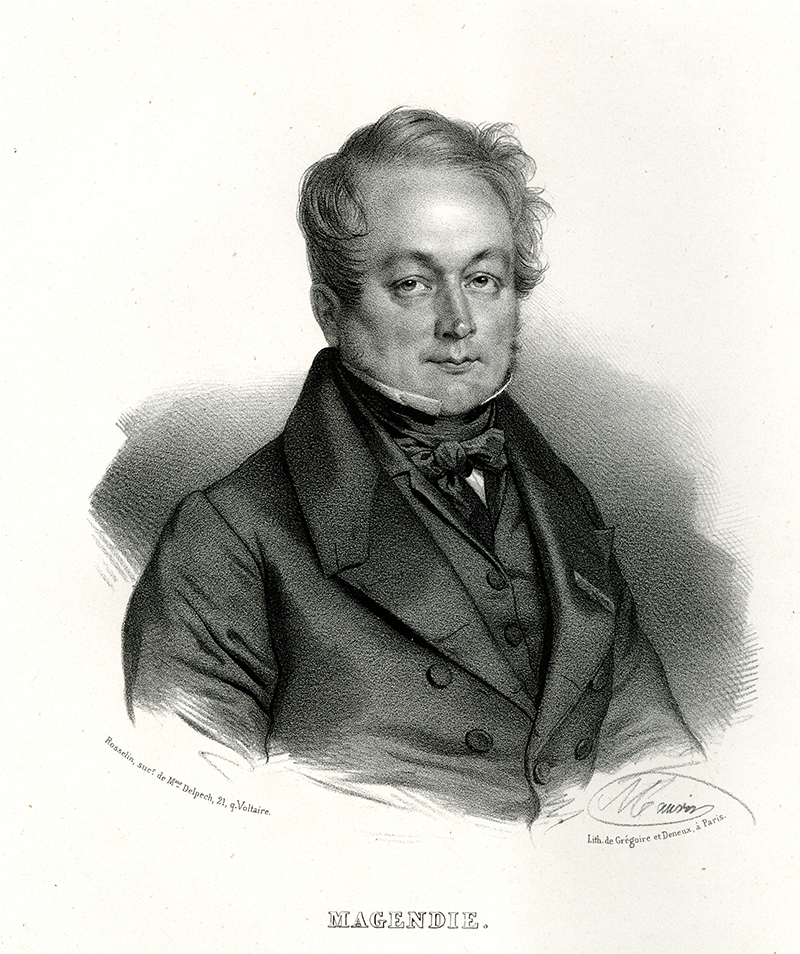Précis élémentaire de physiologie. 2 vols. Paris: Méquignon-Marvis, 1816-1817.
 This Frenchman from Bordeaux was a pioneer in the fields of experimental physiology and experimental pharmacology. A child during the French Revolution, Magendie’s republican father was more concerned with politics than with his surgery practice. Magendie’s mother died while he was still young, and because his father was obsessed with the Rousseauistic ideas of independence over organized education, Magendie did not attend school until the age of ten, and then only upon his own request. He excelled quickly through school, but during these years, the education system in France was unstable and regularly changing its doctrine. This had a lasting effect on Magendie. He became devoted to facts and opposed to theories and conventional dogmas (Dict. Sci. Bio, Vol. 9-10, p. 9). Though he was educated to practice medicine, Magendie chose experimental science as his career. With this, he focused on the verification of isolated facts and rejected attempts at hypotheses and generalizations (Garrison 465).
This Frenchman from Bordeaux was a pioneer in the fields of experimental physiology and experimental pharmacology. A child during the French Revolution, Magendie’s republican father was more concerned with politics than with his surgery practice. Magendie’s mother died while he was still young, and because his father was obsessed with the Rousseauistic ideas of independence over organized education, Magendie did not attend school until the age of ten, and then only upon his own request. He excelled quickly through school, but during these years, the education system in France was unstable and regularly changing its doctrine. This had a lasting effect on Magendie. He became devoted to facts and opposed to theories and conventional dogmas (Dict. Sci. Bio, Vol. 9-10, p. 9). Though he was educated to practice medicine, Magendie chose experimental science as his career. With this, he focused on the verification of isolated facts and rejected attempts at hypotheses and generalizations (Garrison 465).
Francois Magendie’s experimental method was vivisection of unanesthetized animals. Performing this procedure on puppies, he was able to prove that the anterior roots of the spinal nerves function as a motor and the posterior as a sensor. But Magendie was not the only scientist claiming this discovery, which has been identified as the most important in the field of physiology since Harvey (Garrison & Morton 1256). Charles Bell cut the spinal roots and observed that the anterior has more influence over motion, but Magendie determined that these roots have entirely different functions. These two scientists disputed over attribution, and it was eventually named the Bell-Magendie law in recognition of both. Despite the debate, Magendie is certainly responsible for the discovery’s experimental verification (Dict. Sci. Bio., Vol. 9-10, p. 9).
Magendie’s Précis élémentaire de physiologie, an influential textbook on physiology, was published in two volumes, the first in 1816 and the later in 1817. Described by Garrison & Morton as the first modern physiology textbook, it includes descriptions of facts proven by experimentation (597.1). Little attention is given to deductions and conclusions based on doctrines and traditions. The second volume contains experimental proof of the significance of protein in animal diets. This textbook was very influential in medicine and biology throughout the first half of the nineteenth century, and was translated into both English and German (Dict. Sci. Bio., Vol. 9-10, pp. 8-9). The Reynolds-Finley Library has a copy of this textbook from its original publication.
Dict. Sci. Bio, Vol. 9-10, p. 8-10; Garrison, Hist. of Med. 4th Edition, pp. 465-466; Garrison & Morton, Med. Bib., 5thEdition 597.1 & 1256; Heirs of Hippocrates, 818; One Hund. Books, 58; Reynolds Historical Library, Rare books and coll…, 2599.
Image: François Magendie, Print Collection, Reynolds-Finley Historical Library.
